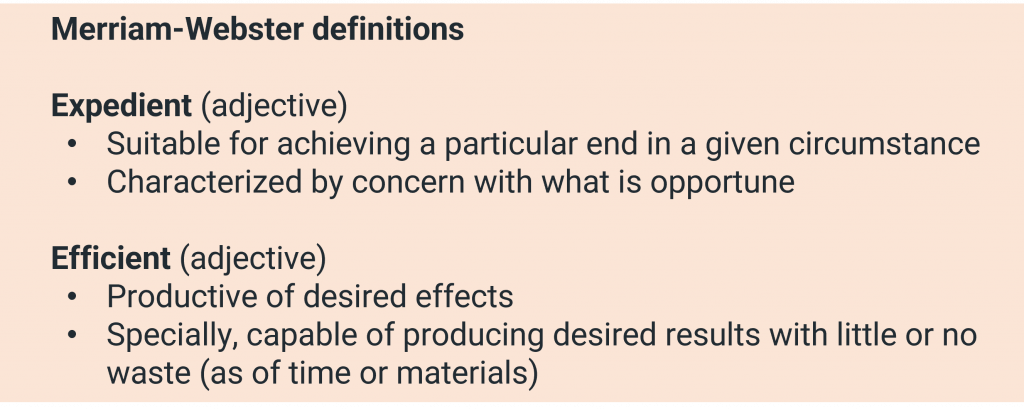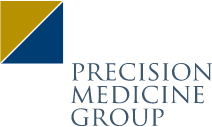By Jason McDonough, Ph.D.
First published in MedAdNews August 2022
Small and midsize biotechs are the engine of innovation in the pharmaceutical and medical device space and are increasingly looking to market their innovations on their own or in partnership with larger firms, rather than focusing on out-licensing. With their laser focus on driving cutting-edge science to quickly demonstrate the value of new therapies, these companies run on exceptionally lean staffing and are constantly looking for the most efficient path forward. This is true from both a marketing/commercial perspective as well as for nascent medical affairs departments, where a single individual is often brought in to build the capability from scratch.
Unfortunately, sometimes the focus is on being expedient rather than efficient, which inevitably leads to challenges and barriers in the not-too-distant future.

Being expedient focuses on today’s challenges and needs, and often means skipping steps, estimating rather than calculating, and doing things quickly. Sometimes the expedient solution is necessary; however, it inevitably leads to more work down the road. This is the essence of efficiency – not just fast, but without wasted time and effort.
There are five key factors to keep in mind to ensure that these innovators are using limited resources and time efficiently.
1. Focus on solid science and evidence, and not just in the lab
New frontiers of medicine are all about speculation and experimentation, but science is fundamentally about evidence. It’s crucial that small companies place the same importance on evidence supporting their commercialization plans as they do on the quality of their preclinical and clinical studies.
For example, are there solid data to back up assumptions about number of patients, where they are located, and current management? It can be expedient to use estimates based on 1-2 interactions with expert treaters, but eventually you will need to back up those estimates with real data. Although true prevalence studies are possible, they are expensive and time-consuming. Efficient solutions could be to leverage machine learning and artificial intelligence to evaluate electronic health records to provide estimates backed by process and data, not just opinion.
2. Process matters and doesn’t need to slow you down
In the excitement of doing something no one else is doing to serve patients with no alternatives, it can seem most efficient to focus on “just getting things done” rather than instituting policies and processes, particularly when you might be a team of one. Many employees in small biotechs have previously worked in large companies where the volume and extent of policies and process can sometimes feel overwhelming, and relish working in a less constricted environment.
However, all small companies eventually discover that processes are there for a reason – so that we can ensure the correct checks and balances, align with industry best practices, and document when and why important decisions were made. Eventually, questions will arise like, “when did we decide to use that word?” or, “who came up with the idea for that visual,” or, “remind me why we’re focused on this sub-analysis.” Having basic systems, processes, and documentation policies is crucial to ensuring we don’t forget where we are headed, which will eventually require meeting specific regulatory and best practice requirements.
3. Streamline processes and procedures early on
Another challenge is that creating and enforcing new policies after a way of working has been established is infinitely more difficult. A simple thing like maintaining a bibliography of all of the completed research studies and publications is very easy to start and maintain from Day One but becomes an incredible headache a couple of years later – particularly if you lose institutional knowledge with team transitions. In the worst case, needing to shift entire ways of operating to ensure that you have the correct compliance systems in place can completely disrupt workflows during critical times, and potentially expose the company to risk.
Focus on efficient, streamlined versions of the processes and procedures implemented every day at large organizations. The best way to streamline is to focus on first principals – what is this process trying to achieve – and documenting the minimal way to accomplish the objective. Creating a simple document saying X role is responsible for saving Y files to Z drive every month makes roles and responsibilities clear for all and can always be updated or expanded as necessary in the future. To reiterate putting the right systems and processes in place to build value early on will not only help you work efficiently and compliantly but will be respected by the medical and scientific – and regulatory – community and demonstrate your leadership.
4. Know your priorities and stick to them
With limited time, money, and resources, small biotechs know they need to prioritize, but inevitably those priorities shift on a weekly (even daily) basis. Further, working on truly transformational therapies can energize teams to shoot for the stars. It is key to maintain a laser focus on the real short- and long-term priorities and focus on doing a limited number of things well.
The top two priorities can be encapsulated as follows:
1. What do we need to satisfy decision makers (e.g., regulators/health authorities, potential partners, and investors)?
This is most often data- and results-driven – having the right data with the right context presented in the right way. Whatever situation arises, we should question if this issue impacts our ability to meet these criteria, and if it doesn’t, then it should not be a priority unless it meets priority two.
2. What is strategically important for us to succeed?
Simply assembling required information for regulatory approval is not enough to have a successful product that HCPs have confidence in prescribing and patients can access and benefit from. By identifying a limited number of specific strategic objectives, small companies can ensure that they can efficiently deliver on each of those needs.
Sticking to your priorities is the most effective way to be efficient. If you are convinced a specific initiative or approach should be a priority, but it doesn’t align with either of these top two priorities, it may be time to revisit your strategic objectives.
5. Listen to your stakeholders and get beyond the inner circle
Large companies are able to seek input and guidance from large numbers of HCPs, patients, and other stakeholders, while small biotechs must be more nimble and often gravitate to a handful of therapeutic area experts (and sometimes just one or two) for input and direction.
When working with a small advisory group, it is crucial to really listen to the advice you are given and treat these advisors as partners – if you disagree with their assessment, have a discussion to understand their point of view, as it’s likely to be shared by others. By delving into these areas of uncertainty or disagreement, you can learn a great deal about the most effective path forward, sometimes ending in completely reshaping strategy and internal company thinking.
Small companies often wait too long to engage with HCPs outside of their small advisor circle and can encounter unforeseen barriers later in development. Even in ultra-rare diseases where the number of physician experts can be counted on one hand, these advisors are inevitably supported by an entire team of HCPs who will have valuable insights into processes of care and treatment/disease management that need to be understood.
I’ll never forget being at a multidisciplinary advisory board for a small medical device company and chatting with a hospital-based NP over lunch who said, “The science looks great, and this is such an important product, but this will never work in my ward.” This remark led to an entire shift in strategy to focus on how to integrate into existing pathways and processes, rather than creating and implementing a whole new pathway.
Closing thoughts
Working in and with small biotechs is energizing and exciting – fascinating science, brilliant people, and the promise of making transformational change for patients. All this talk of efficiency, process, and limited priorities can be seen as the boring side of this business, but I truly believe that they are the best way to ensure you have the time, energy, and focus to truly engage in the big picture: transforming the lives of patients.

Jason McDonough, Ph.D., is SVP, Medical Strategy for PRECISIONscientia.







